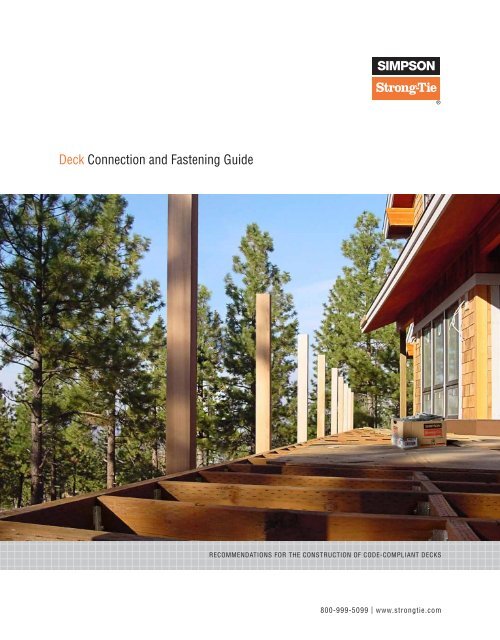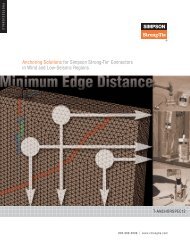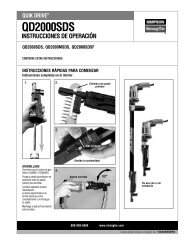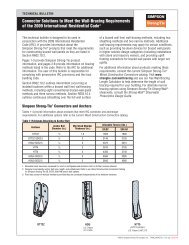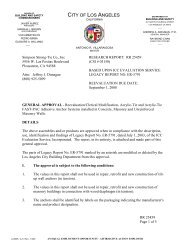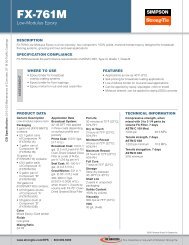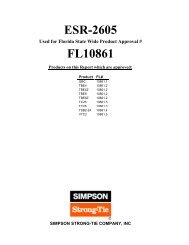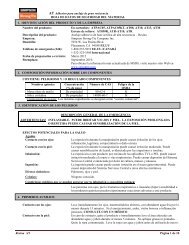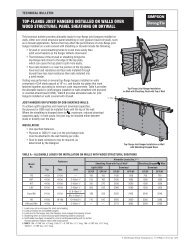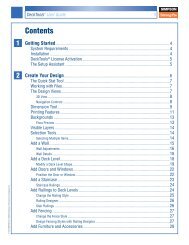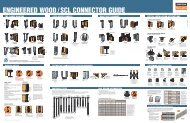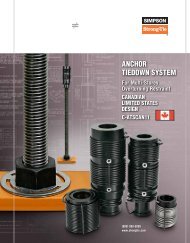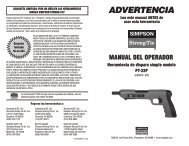Deck Connection and Fastening Guide - Simpson Strong-Tie
Deck Connection and Fastening Guide - Simpson Strong-Tie
Deck Connection and Fastening Guide - Simpson Strong-Tie
You also want an ePaper? Increase the reach of your titles
YUMPU automatically turns print PDFs into web optimized ePapers that Google loves.
<strong>Deck</strong> <strong>Connection</strong> <strong>and</strong> <strong>Fastening</strong> <strong>Guide</strong><br />
RECOMMENDATIONS FOR THE CONSTRUCTION OF CODE-COMPLIANT DECKS<br />
800-999-5099 | www.strongtie.com
Contents<br />
Introduction — Improperly Built <strong>Deck</strong>s Can Be Dangerous .............3<br />
Code Concerns ..............................................4<br />
Critical <strong>Deck</strong> <strong>Connection</strong>s ......................................5<br />
Existing <strong>Deck</strong>s: Retrofit or Replace .............................6–7<br />
Ledger Attachment ...........................................8<br />
Lateral Load <strong>Connection</strong> .......................................9<br />
Footings ...................................................10<br />
Post Bases ..............................................11–12<br />
Beam-to-Post <strong>Connection</strong>s ....................................13<br />
Joists Terminating into Beam/Ledger. . . . . . . . . . . . . . . . . . . . . . . . . . . . 14<br />
Joists Bearing on a Beam .....................................15<br />
Railing Post-to-<strong>Deck</strong> Framing .................................16<br />
Stair Stringers & Treads ......................................17<br />
Selecting Connectors <strong>and</strong> Fasteners ............................18<br />
Stainless-Steel Connectors ...................................19<br />
Correct Fasteners for Use with <strong>Simpson</strong> <strong>Strong</strong>-<strong>Tie</strong> Connectors .......20<br />
Structural Wood <strong>Fastening</strong> ....................................21<br />
Corrosion-Resistant Fasteners for <strong>Deck</strong>ing ....................22–23<br />
Quik Drive Auto-Feed Screw Driving System for <strong>Deck</strong>s ..............24<br />
Color Match Fasteners for Composite <strong>and</strong> PVC <strong>Deck</strong>ing .............25<br />
EB-TY ® <strong>and</strong> Fastener Finder ...................................26<br />
<strong>Deck</strong>Tools ® – <strong>Deck</strong> Sales <strong>and</strong> Design Software ....................27<br />
A Word About Building Codes<br />
This guide recommends connectors <strong>and</strong> fasteners for deck<br />
construction that may meet the requirements of the 2009/2012<br />
International Building Code ® <strong>and</strong> the 2009/2012 International<br />
Residential Code ® . The information contained here is a<br />
summary of the requirements of these codes as they pertain<br />
to the connections highlighted in this guide. The building<br />
codes contain other requirements regarding aspects of deck<br />
International Building Code <strong>and</strong> International Residential Code are registered trademarks of their respective organizations.<br />
Limited Warranty<br />
<strong>Simpson</strong> <strong>Strong</strong>-<strong>Tie</strong> Company Inc. warrants catalog products to be free from<br />
defects in material or manufacturing. <strong>Simpson</strong> <strong>Strong</strong>-<strong>Tie</strong> Company Inc.<br />
products are further warranted for adequacy of design when used in accordance<br />
with design limits in this catalog <strong>and</strong> when properly specified, installed, <strong>and</strong><br />
maintained. This warranty does not apply to uses not in compliance with<br />
specific applications <strong>and</strong> installations set forth in this catalog, or to non-catalog<br />
or modified products, or to deterioration due to environmental conditions.<br />
<strong>Simpson</strong> <strong>Strong</strong>-<strong>Tie</strong> ® connectors are designed to enable structures to resist<br />
the movement, stress, <strong>and</strong> loading that results from impact events such as<br />
earthquakes <strong>and</strong> high velocity winds. Other <strong>Simpson</strong> <strong>Strong</strong>-<strong>Tie</strong> products are<br />
designed to the load capacities <strong>and</strong> uses listed in this catalog. Properly-installed<br />
<strong>Simpson</strong> <strong>Strong</strong>-<strong>Tie</strong> products will perform in accordance with the specifications<br />
set forth in the applicable <strong>Simpson</strong> <strong>Strong</strong>-<strong>Tie</strong> catalog. Additional performance<br />
limitations for specific products may be listed on the applicable catalog pages.<br />
Due to the particular characteristics of potential impact events, the<br />
specific design <strong>and</strong> location of the structure, the building materials<br />
Visit the <strong>Deck</strong> Center at<br />
www.strongtie.com/deckcenter<br />
Everything You Need in One Place<br />
We have brought together all of our<br />
information <strong>and</strong> training on building<br />
stronger, safer decks in one location<br />
to make learning easier than ever.<br />
construction that are not addressed here, check the codes for<br />
details. Check with your local building department to verify<br />
what building codes have been adopted in your area.<br />
Selection of products based upon performance <strong>and</strong>/or suitability for<br />
a specific application should be made by a qualified professional.<br />
<strong>Simpson</strong> <strong>Strong</strong>-<strong>Tie</strong> recommends that deck designs are approved<br />
by the local building department before construction begins.<br />
used, the quality of construction, <strong>and</strong> the condition of the soils involved,<br />
damage may nonetheless result to a structure <strong>and</strong> its contents even if the<br />
loads resulting from the impact event do not exceed <strong>Simpson</strong> <strong>Strong</strong>-<strong>Tie</strong><br />
catalog specifications <strong>and</strong> <strong>Simpson</strong> <strong>Strong</strong>-<strong>Tie</strong> connectors are<br />
properly installed in accordance with applicable building codes.<br />
All warranty obligations of <strong>Simpson</strong> <strong>Strong</strong>-<strong>Tie</strong> Company Inc. shall be limited,<br />
at the discretion of <strong>Simpson</strong> <strong>Strong</strong>-<strong>Tie</strong> Company Inc., to repair or replacement<br />
of the defective part. These remedies shall constitute <strong>Simpson</strong> <strong>Strong</strong>-<strong>Tie</strong><br />
Company Inc.’s sole obligation <strong>and</strong> sole remedy of purchaser under this<br />
warranty. In no event will <strong>Simpson</strong> <strong>Strong</strong>-<strong>Tie</strong> Company Inc. be responsible<br />
for incidental, consequential, or special loss or damage, however caused.<br />
This warranty is expressly in lieu of all other warranties, expressed<br />
or implied, including warranties of merchantability or fitness<br />
for a particular purpose, all such other warranties being hereby<br />
expressly excluded. This warranty may change periodically – consult<br />
our website www.strongtie.com for current information.<br />
2 | DECK CONNECTION AND FASTENING GUIDE F-DECKCODE13 © 2013 SIMPSON STRONG-TIE COMPANY INC.
Introduction<br />
Improperly Built <strong>Deck</strong>s Can Be Dangerous<br />
More than a million decks are built <strong>and</strong> replaced each<br />
year in the United States. While decks are a popular<br />
feature of many homes, the construction <strong>and</strong> safety of<br />
decks have become a real concern within the building<br />
industry. Improper deck building has resulted in a growing<br />
number of deck failures <strong>and</strong> related injuries <strong>and</strong> deaths.<br />
“ <strong>Deck</strong>s cause more injuries <strong>and</strong><br />
loss of life than any other part of<br />
the home structure.<br />
”<br />
—Don Bender, Director, Composite Materials <strong>and</strong><br />
Engineering Center, Washington State University<br />
According to Don Bender, the director of the Composite<br />
Materials <strong>and</strong> Engineering Center at Washington State<br />
University, the deck is the most dangerous part of the<br />
house. Washington State Magazine’s article Making<br />
<strong>Deck</strong>s Safer reports “<strong>Deck</strong>s cause more injuries <strong>and</strong><br />
loss of life than any other part of the home structure.<br />
Except for hurricanes <strong>and</strong> tornadoes, more injuries<br />
may be connected to deck failures than all other wood<br />
building components <strong>and</strong> loading cases combined.”<br />
While decks are required to meet certain code st<strong>and</strong>ards<br />
<strong>and</strong> load capacities, it’s estimated that of the 40 million<br />
existing decks, only half are code compliant — leaving<br />
20 million decks that need to be rebuilt or retrofitted.<br />
To help design <strong>and</strong> building professionals build codecompliant,<br />
safe decks, <strong>Simpson</strong> <strong>Strong</strong>-<strong>Tie</strong> has created<br />
this <strong>Deck</strong> <strong>Connection</strong> <strong>and</strong> <strong>Fastening</strong> <strong>Guide</strong>. This guide<br />
focuses on the critical connections involved in deck<br />
construction <strong>and</strong> what the code requires for these areas.<br />
It is intended to help designers, contractors, inspectors<br />
<strong>and</strong> do-it-yourselfers ensure that their decks are properly<br />
constructed per the International Building Code ® (IBC) <strong>and</strong><br />
International Residential Code ® (IRC). The guide includes<br />
a complete deck connector system that covers all the<br />
hardware needs for deck construction <strong>and</strong> references<br />
the code to ensure it meets current requirements.<br />
F-DECKCODE13 © 2013 SIMPSON STRONG-TIE COMPANY INC. DECK CONNECTION AND FASTENING GUIDE | 3
Code Concerns<br />
Do <strong>Deck</strong>s Really<br />
Need to Meet Code<br />
Requirements?<br />
Because they look relatively simple to build, many people<br />
do not realize that decks are structures that need to be<br />
designed to adequately resist certain stresses. Like a<br />
house, or any other building, a deck must be designed<br />
to support the weight of people <strong>and</strong> objects placed on<br />
them, as well as lateral <strong>and</strong> uplift loads that can act on<br />
the deck as a result of occupant movement, wind or<br />
seismic activity. The 2009/2012 versions of both the<br />
IBC <strong>and</strong> IRC contain language outlining the general<br />
design requirements of structures. This excerpt from<br />
the 2009/2012 IRC (Section R301.1) represents a<br />
summary of the intent of both codes:<br />
“The construction of buildings <strong>and</strong> structures in accordance<br />
with the provisions of this code shall result in a system that<br />
provides a complete load path that meets all requirements for<br />
the transfer of all loads from their point of origin through<br />
the load-resisting elements to the foundation.”<br />
The concept of a complete or continuous load path refers to a series of solid connections within the structure of<br />
a deck that transfer load through its frame to the ground or adjacent, supporting structure (commonly a building).<br />
This same principle is applied to the design of all types of wood frame buildings. This continuous load path is<br />
created by using a system of structural connectors <strong>and</strong> fasteners to connect the wood members together.<br />
Common Code Violations<br />
The following code requirements can be easily overlooked in deck construction:<br />
1. Proper fastening of the ledger connection<br />
The building code prohibits the “use of<br />
toenails or nails subject to withdrawal”<br />
when making this connection, yet a number<br />
of deck failures result due to using these<br />
or other types of improper fasteners.<br />
2. Proper fastening of guardrails to the deck<br />
The IRC requires the guardrail to resist<br />
a 200-pound load. This load applied<br />
at the top of the guardrail, creates a<br />
large leverage force where the guardrail<br />
attaches to the deck framing.<br />
3. Post-base connections<br />
The IRC requires posts “be restrained<br />
to prevent lateral displacement at the<br />
bottom end”. This requirement is<br />
important as most decks cannot safely<br />
support part or all of its structure,<br />
if a post is removed.<br />
4. Openings in guards <strong>and</strong> stair railings<br />
The building code places a limit on<br />
the size of openings, for the occupant’s<br />
safety in case of tripping or falling,<br />
or the safety of small children.<br />
4 | DECK CONNECTION AND FASTENING GUIDE F-DECKCODE13 © 2013 SIMPSON STRONG-TIE COMPANY INC.
Critical <strong>Deck</strong> <strong>Connection</strong>s<br />
A system of key connections throughout the deck framing, also known as a continuous load path, is essential to<br />
building a safe, code-compliant deck. When this system of connections is made properly, loads are transferred<br />
throughout the deck’s frame <strong>and</strong> into the ground <strong>and</strong>/or the adjacent structure to which the deck is connected.<br />
The connections called out below are necessary in order to create an effective continuous load path.<br />
For information on the inspection of existing decks, see page 7.<br />
Lateral Load<br />
<strong>Connection</strong> (page 9)<br />
Ledger Attachment<br />
(page 8)<br />
Joist-to-Ledger<br />
(page 14)<br />
Beam-to-Post<br />
(page 13)<br />
Railing Post-to-<br />
<strong>Deck</strong> Framing<br />
(page 16)<br />
Joist-to-Beam<br />
(page 15)<br />
Stair Stringer-to-<br />
<strong>Deck</strong> Framing<br />
(page 17)<br />
Post-to-Concrete<br />
(page 11–12)<br />
Stair Tread-to-<br />
Stringer (page 17)<br />
F-DECKCODE13 © 2013 SIMPSON STRONG-TIE COMPANY INC. DECK CONNECTION AND FASTENING GUIDE | 5
Existing <strong>Deck</strong>s: Retrofit or Replace<br />
Do I Need To Retrofit?<br />
Retrofitting an Existing <strong>Deck</strong><br />
It is estimated that of the approximately 40 million existing<br />
decks, only half are code-compliant. Experts believe that<br />
it is likely that many of these decks are potentially unsafe.<br />
In situations where it is not feasible to rebuild an existing<br />
deck, it may be preferable to retrofit it by applying hardware<br />
to existing framing members. Many of the products<br />
shown in this guide may be installed after deck framing<br />
is in place <strong>and</strong> can improve the safety of the structure<br />
<strong>and</strong> help bring it within the requirements of the code.<br />
The Life Expectancy of <strong>Deck</strong>s<br />
Most experts agree that the average life expectancy of a<br />
deck is 10 to 15 years. Since deck building started over<br />
30 years ago, there are many existing decks that are past<br />
their useful life. <strong>Deck</strong> maintenance is often overlooked as<br />
well. <strong>Deck</strong>s are exposed to the elements, which can cause<br />
damage. It’s important that decks are properly inspected<br />
<strong>and</strong> maintained on a routine basis. If unsure it’s best to<br />
consult with a professional, such as a structural engineer,<br />
architect, home inspector, or contractor in order to make<br />
sure the deck is safe.<br />
Connector Solutions for Retrofitting<br />
The following connectors are some of the products<br />
that may be suitable for deck retrofit. Selection<br />
of products based upon performance <strong>and</strong>/or<br />
suitability for a specific application should be made<br />
by a qualified professional. <strong>Simpson</strong> <strong>Strong</strong>-<strong>Tie</strong><br />
recommends that deck designs be approved by the<br />
local building department before work begins.<br />
LCE/AC Retrofit Post Caps: Two-piece cap may<br />
be installed before or after lumber is in place.<br />
DJT: Connects beams<br />
at the side of the post.<br />
H1 Hurricane <strong>Tie</strong>: Holds joist on both sides.<br />
LUS Joist Hanger: Provides bearing<br />
<strong>and</strong> uplift resistance, features doubleshear<br />
nailing for added strength.<br />
DTT <strong>Deck</strong> Tension <strong>Tie</strong>: Horizontal application<br />
fastening railing post to deck framing.<br />
6 | DECK CONNECTION AND FASTENING GUIDE F-DECKCODE13 © 2013 SIMPSON STRONG-TIE COMPANY INC.
Existing <strong>Deck</strong>s: Retrofit or Replace?<br />
5 Things to Look for On an Existing <strong>Deck</strong><br />
1 2345<br />
When inspecting a deck to determine overall safety <strong>and</strong> compliance to building codes, look at the five areas below.<br />
Use this check list to help ensure a thorough evaluation.<br />
Improper <strong>Connection</strong>s<br />
Any connections that do not meet the requirements discussed in this guide can<br />
compromise the safety of the deck. In many cases toenailing (i.e. joining two wood<br />
members with angled nailing) does not constitute a proper connection. Connectors<br />
must be installed with the correct fastener.<br />
Loose <strong>Connection</strong>s<br />
Vital connections may have degraded over time. Wobbly railings, loose stairs <strong>and</strong><br />
ledgers that appear to be pulling away from the adjacent structure are all causes<br />
for concern.<br />
Corrosion<br />
Metal connectors <strong>and</strong> fasteners can corrode over time, especially if a product with<br />
insufficient corrosion resistance was originally installed. See page 18 for more<br />
information on corrosion.<br />
Rot<br />
Wood can rot <strong>and</strong> degrade over time with exposure to the elements. Members within<br />
the deck frame that have rotted may no longer be able to perform the function for<br />
which they were installed.<br />
Cracks<br />
As wood ages it is common for cracks to develop. Large cracks or excessive cracking<br />
overall can weaken deck framing members.<br />
F-DECKCODE13 © 2013 SIMPSON STRONG-TIE COMPANY INC. DECK CONNECTION AND FASTENING GUIDE | 7
xterior cladding<br />
nd flashing not<br />
own for clarity<br />
Ledger Attachment<br />
Code Requirements<br />
Where supported by attachment<br />
to an exterior wall, decks shall<br />
be positively anchored to the<br />
primary structure <strong>and</strong> designed<br />
for both vertical <strong>and</strong> lateral<br />
loads. Such attachment shall<br />
not be accomplished by the use<br />
of toenails or nails subject to<br />
withdrawal.<br />
IRC 2009 Section R502.2.2<br />
IRC 2012 Section R507.1<br />
IBC 2009/2012 Section 1604.8.3<br />
For decks supporting a total<br />
design load of 50 pounds per<br />
square foot (40 pounds per<br />
square foot live load plus 10<br />
pounds per square foot dead<br />
load), the connection between<br />
a deck ledger of pressure<br />
preservative-treated Southern<br />
Pine, incised pressurepreservative-treated<br />
Hem-Fir<br />
or approved decay-resistant<br />
species, <strong>and</strong> a 2-inch nominal<br />
lumber b<strong>and</strong> joist bearing on<br />
a sill plate or wall plate shall<br />
be constructed with ½-inch lag<br />
screws or bolts with washers in<br />
accordance with Table R502.2.2.1<br />
(IRC 2012 Table R507.2).<br />
IRC 2009 Section R502.2.2.1<br />
IRC 2012 Section R507.2<br />
<strong>Deck</strong> ledger connections not<br />
conforming to Table R502.2.2.1<br />
(IRC 2012 Table R507.2) shall<br />
be designed in accordance with<br />
accepted engineering practice.<br />
Girders supporting deck joists<br />
shall not be supported on deck<br />
ledgers or b<strong>and</strong> joists. <strong>Deck</strong><br />
ledgers shall not be supported<br />
on stone or masonry veneer.<br />
IRC 2009, Section panel sheathing R502.2.2.2.<br />
1 ⁄2" max. thickness<br />
IRC 2012 Section R507.2.2<br />
Selection of products based upon<br />
performance <strong>and</strong>/or suitability for<br />
a specific application should be<br />
Floor<br />
joist or<br />
blocking<br />
Wood structural<br />
fastened per code<br />
B<strong>and</strong> joist<br />
made by a qualified SDWS professional.<br />
or SDWH<br />
wood screws<br />
<strong>Simpson</strong> <strong>Strong</strong>-<strong>Tie</strong> recommends<br />
that deck designs be approved<br />
by the local building department<br />
2" nominal deck<br />
before construction ledger begins. shown<br />
(double 2"<br />
ledger similar)<br />
One of the most common causes for<br />
deck failure is ledgers that pull away<br />
from the primary structure, resulting in<br />
complete collapse.<br />
The <strong>Simpson</strong> <strong>Strong</strong>-<strong>Tie</strong> <strong>Strong</strong>-Drive<br />
SDWS <strong>and</strong> SDWH structural wood screws<br />
provide an easy-to-install, high-strength<br />
alternative to lag screws <strong>and</strong> throughbolts.<br />
They are ideal for securely attaching<br />
ledgers to structural wood members, are<br />
easier to drive than comparable fasteners,<br />
<strong>and</strong> are coated for many exterior <strong>and</strong><br />
preservative-treated wood applications.<br />
<strong>Strong</strong>-Drive ® Structural Wood Screw<br />
0.75"<br />
0.64"<br />
Ledger fastener spacing<br />
may be offset up to 3"<br />
to avoid interference<br />
with joist attachment<br />
11 0.195" ⁄2" minimum from<br />
top of ledger <strong>and</strong> b<strong>and</strong> joist<br />
6" from<br />
end of ledger<br />
Exterior cladding<br />
<strong>and</strong> flashing not<br />
shown for clarity<br />
On-center spacing<br />
of SDWS or SDWH<br />
wood screws<br />
Floor<br />
joist or<br />
blocking<br />
Ledger-to-B<strong>and</strong> Joist<br />
Assembly<br />
SDWS/SDWH Screw Spacing Detail<br />
1 1 ⁄2" minimum from<br />
bottom of ledger<br />
<strong>and</strong> b<strong>and</strong> joist<br />
For more information on ledger attachment see <strong>Fastening</strong> Systems catalog C-FS <strong>and</strong><br />
flier F-SDWSSDWH.<br />
Wood structural<br />
panel sheathing<br />
1 ⁄2" max. thickness<br />
fastened per code<br />
B<strong>and</strong> joist<br />
SDWS or SDWH<br />
wood screws<br />
2" nominal deck<br />
ledger shown<br />
(double 2"<br />
ledger similar)<br />
3" minimum<br />
row spacing<br />
8 | DECK CONNECTION AND FASTENING GUIDE F-DECKCODE13 © 2013 SIMPSON STRONG-TIE COMPANY INC.<br />
0.220"<br />
• 4CUT tip, serrated thread, <strong>and</strong><br />
knurled shank reduce installation torque<br />
• Identification on all screw heads<br />
• Low-profile washer head provides excellent<br />
bearing area <strong>and</strong> a clean look<br />
Code listed per IAPMO UES ER-192.<br />
SDWS<br />
U.S. Patents<br />
5,897,280; 7,101,133,<br />
For stainless-steel ledger fastening,<br />
use the <strong>Strong</strong>-Drive SDS structural<br />
wood screw (page 21).
Lateral-Load <strong>Connection</strong><br />
For decks that are partially supported by an adjacent<br />
structure, the connection between the deck <strong>and</strong><br />
that structure is vital. A bolted or screwed ledgerto-rim<br />
board connection is suitable to support<br />
gravity loads, however in some cases the building<br />
codes require a connection that is able to resist<br />
higher lateral loads. In these situations tension<br />
ties are typically called out to tie the joists of the<br />
deck directly to the joists of the structure.<br />
The <strong>Simpson</strong> <strong>Strong</strong>-<strong>Tie</strong> ® DTT2 <strong>Deck</strong> Tension <strong>Tie</strong><br />
complies with IRC provisions for laterally tying the deck<br />
to the house. The DTT2 fastens easily to the joist using<br />
<strong>Simpson</strong> <strong>Strong</strong>-<strong>Tie</strong> ® <strong>Strong</strong> Drive ® screws (included).<br />
For more information<br />
on common framing<br />
conditions not<br />
addressed by the<br />
2009/2012 IRC<br />
detail, refer to<br />
<strong>Simpson</strong> <strong>Strong</strong>-<strong>Tie</strong><br />
technical bulletin<br />
T-DECKLATLOAD.<br />
½" diameter<br />
HDG threaded<br />
rod with nuts<br />
<strong>and</strong> washers<br />
Floor joist<br />
(Solid 2x joist or<br />
2x blocking)<br />
The DTT2Z <strong>Deck</strong> Tension <strong>Tie</strong> is<br />
a multi-purpose connector ideal<br />
for lateral load <strong>and</strong> deck-post<br />
connections. It features a ZMAX ®<br />
coating for added corrosion<br />
resistance. For stainless steel<br />
model use the DTT2SS.<br />
<strong>Deck</strong> to Ledger<br />
Installation Detail<br />
Floor sheathing<br />
nailed at 6" max.<br />
on center to joist<br />
with holdown<br />
Continuous flashing<br />
(per code), not shown<br />
<strong>Deck</strong><br />
joist<br />
Code Requirements<br />
The lateral load connection<br />
required by Section R502.2.2<br />
shall be permitted to be in<br />
accordance with Figure<br />
R502.2.2.3. Hold-down tension<br />
devices shall be installed in<br />
not less than two locations<br />
per deck, <strong>and</strong> each device shall<br />
have an allowable stress design<br />
capacity of not less than<br />
1500 pounds.<br />
IRC 2009 Section R502.2.2.3<br />
The lateral load connection<br />
required by Section R507.1<br />
shall be permitted to be in<br />
accordance with Figure R507.2.3.<br />
Where the lateral load<br />
connection is provided in<br />
accordance with Figure R507.2.3,<br />
hold-down tension devices<br />
shall be installed in not less<br />
than two locations per deck,<br />
<strong>and</strong> each device shall have an<br />
allowable stress design capacity<br />
of not less than 1500 pounds.<br />
IRC 2012 Section R507.2.3<br />
Selection of products based upon<br />
performance <strong>and</strong>/or suitability for<br />
a specific application should be<br />
made by a qualified professional.<br />
<strong>Simpson</strong> <strong>Strong</strong>-<strong>Tie</strong> recommends<br />
that deck designs be approved<br />
by the local building department<br />
before construction begins.<br />
F-DECKCODE13 © 2013 SIMPSON STRONG-TIE COMPANY INC. DECK CONNECTION AND FASTENING GUIDE | 9<br />
DTT2Z<br />
2"<br />
<strong>Deck</strong> to Ledger<br />
Installation<br />
Section View<br />
These products are available with a ZMAX ®<br />
or hot-dip galvanized coating. Stainlesssteel<br />
connectors are also available for higher<br />
exposure environments or applications<br />
using certain preservative-treated woods.<br />
See page 18 for more details.
Footings<br />
Code Requirements<br />
Footings<br />
The building codes include<br />
specific requirements regarding<br />
footing size that are dependent<br />
upon factors such as the dead<br />
<strong>and</strong> live loads the deck is<br />
designed to resist as well as<br />
soil conditions. Footing should<br />
be designed per<br />
IRC 2009/2012, Section R403 or<br />
IBC 2009/2012, Chapter 18<br />
Minimum Footing Depths By Code<br />
(See the codes for actual<br />
footing size required.)<br />
Footings shall be at least<br />
12" below the undisturbed<br />
ground surface.<br />
IRC 2009/2012, Section R403.1.4<br />
The size of footings supporting<br />
piers <strong>and</strong> columns shall be<br />
based on the tributary load<br />
<strong>and</strong> allowable soil pressure in<br />
accordance with Table R401.4.1.<br />
IRC 2009/2012 Section R403.1.1<br />
Note: In order to achieve<br />
published load values, footings<br />
must provide sufficient concrete<br />
cover of the embedded portion of<br />
<strong>Simpson</strong> <strong>Strong</strong>-<strong>Tie</strong> ® cast-in-place<br />
post <strong>and</strong> column bases. In some<br />
cases a footing larger than the<br />
minimum required by the building<br />
codes will be necessary to<br />
meet these requirements.<br />
See the <strong>Simpson</strong> <strong>Strong</strong>-<strong>Tie</strong> ®<br />
Wood Construction Connectors<br />
catalog for more information.<br />
In order for posts to properly resist various types of loads they must be supported<br />
by, <strong>and</strong> anchored to, concrete footings. Concrete patios <strong>and</strong> pre-cast concrete piers<br />
do not qualify as proper footings for deck construction.<br />
10 | DECK CONNECTION AND FASTENING GUIDE F-DECKCODE13 © 2013 SIMPSON STRONG-TIE COMPANY INC.
Post Bases (Hardened Concrete)<br />
Posts must be correctly attached to a concrete footing in order to resist lateral<br />
<strong>and</strong> uplift loads. Preservative treated wood that is cut must be field treated or<br />
the post must be elevated off the concrete by 1".<br />
<strong>Simpson</strong> <strong>Strong</strong>-<strong>Tie</strong> ® Solutions<br />
These products utilize anchors installed during the pour or<br />
after the concrete hardens.<br />
ABW Adjustable Post<br />
Base with St<strong>and</strong>off<br />
Available in<br />
ZMAX ® coating.<br />
ABU Adjustable Post<br />
Base with St<strong>and</strong>off<br />
ZMAX coating or<br />
stainless steel<br />
recommended.<br />
EPB44PHDG<br />
Elevated Post Base<br />
Available with hot-dip<br />
galvanized coating<br />
Post-Installed Anchors<br />
Installing a post base on hardened concrete requires the installation of a<br />
post-installed anchor to attach the base to the concrete. <strong>Simpson</strong> <strong>Strong</strong>-<strong>Tie</strong><br />
offers a variety of mechanical anchors <strong>and</strong> anchoring adhesives that are<br />
code listed for structural applications.<br />
Mechanical Anchors:<br />
<strong>Strong</strong>-Bolt ® 2 Wedge Anchor<br />
The <strong>Strong</strong>-Bolt ® 2 wedge anchor is the<br />
next-generation solution for cracked <strong>and</strong><br />
uncracked concrete. Available in stainless steel,<br />
it is code-listed by ICC-ES under the 2009 IBC<br />
requirements for post-installed anchors in<br />
cracked <strong>and</strong> uncracked concrete<br />
Anchoring Adhesives<br />
Anchoring adhesives are ideal when maximum<br />
strength is needed or when anchoring close to the<br />
edge of concrete or masonry. <strong>Simpson</strong> <strong>Strong</strong>- <strong>Tie</strong> ®<br />
SET-XP ® epoxy is a high-strength epoxy adhesive<br />
<strong>and</strong> AT-XP ® is an acrylic formula ideal for fast cure<br />
<strong>and</strong> cold-weather applications. Both products are<br />
available in a variety of cartridge sizes, including<br />
convenient single-tube cartridges. Hot-dip galvanized<br />
or stainless-steel threaded rod recommended.<br />
For more information on these products see the <strong>Simpson</strong> <strong>Strong</strong>-<strong>Tie</strong> ®<br />
Anchoring <strong>and</strong> <strong>Fastening</strong> Systems for Concrete <strong>and</strong> Masonry catalog<br />
or visit www.strongtie.com/anchors.<br />
CPTZ Concealed<br />
Post <strong>Tie</strong><br />
Available in<br />
ZMAX coating.<br />
Code Requirements<br />
Load Resistance<br />
Columns shall be restrained to<br />
prevent lateral displacement at<br />
the bottom end. Wood columns<br />
shall not be less in nominal<br />
size than 4" x 4".<br />
IRC 2009/2012, Section R407.3<br />
Column <strong>and</strong> post-end<br />
connections shall be fastened<br />
to resist lateral <strong>and</strong> net induced<br />
uplift forces.<br />
IBC 2009/2012, Section 2304.9.7<br />
Decay Resistance of Post<br />
Wood columns shall be<br />
approved wood of natural<br />
decay resistance or approved<br />
pressure-preservative-treated<br />
wood. Exception: Columns<br />
exposed to the weather when<br />
supported by concrete piers<br />
or metal pedestals projecting<br />
1" above a concrete floor or 6"<br />
above exposed earth <strong>and</strong> the<br />
earth is covered by an approved<br />
impervious moisture barrier.<br />
IRC 2009/2012 Section R317.1.4<br />
IBC 2009/2012 Section 2304.11.2.7<br />
Selection of products based upon<br />
performance <strong>and</strong>/or suitability for<br />
a specific application should be<br />
made by a qualified professional.<br />
<strong>Simpson</strong> <strong>Strong</strong>-<strong>Tie</strong> recommends<br />
that deck designs be approved<br />
by the local building department<br />
before construction begins.<br />
F-DECKCODE13 © 2013 SIMPSON STRONG-TIE COMPANY INC. DECK CONNECTION AND FASTENING GUIDE | 11
Post Bases (Wet Concrete)<br />
Code Requirements<br />
Load Resistance<br />
Columns shall be restrained<br />
to prevent lateral displacement<br />
at the bottom end. Wood<br />
columns shall not be less in<br />
nominal size than 4" x 4".<br />
IRC 2009/2012, Section R407.3<br />
Column <strong>and</strong> post-end<br />
connections shall be fastened<br />
to resist lateral <strong>and</strong> net induced<br />
uplift forces.<br />
IBC 2009/2012, Section 2304.9.7<br />
Decay Resistance of Post<br />
Wood columns shall be<br />
approved wood of natural<br />
decay resistance or approved<br />
pressure-preservative-treated<br />
wood. Exception: Columns<br />
exposed to the weather when<br />
supported by concrete piers<br />
or metal pedestals projecting<br />
1" above a concrete floor or 6"<br />
above exposed earth <strong>and</strong> the<br />
earth is covered by an approved<br />
impervious moisture barrier.<br />
IRC 2009/2012 Section R317.1.4<br />
IBC 2009/2012 Section 2304.11.2.7<br />
Selection of products based upon<br />
performance <strong>and</strong>/or suitability for<br />
a specific application should be<br />
made by a qualified professional.<br />
<strong>Simpson</strong> <strong>Strong</strong>-<strong>Tie</strong> recommends<br />
that deck designs be approved<br />
by the local building department<br />
before construction begins.<br />
These products are available with a ZMAX ®<br />
or hot-dip galvanized coating. Stainlesssteel<br />
connectors are also available for higher<br />
exposure environments or applications<br />
using certain preservative-treated woods.<br />
See page 18 for more details.<br />
<strong>Simpson</strong> <strong>Strong</strong>-<strong>Tie</strong> ® Solutions<br />
Cast-in-Place<br />
These products are cast into the concrete at the time of the pour.<br />
PB Post Base:<br />
For use with decay<br />
resistant or preservativetreated<br />
wood. ZMAX ®<br />
or hot-dip galvanized<br />
coating recommended.<br />
PBS Post Base<br />
with St<strong>and</strong>off:<br />
Features a 1" st<strong>and</strong>off.<br />
ZMAX or hot-dip<br />
galvanized coating<br />
recommended.<br />
CBSQ Column Base:<br />
Installs with <strong>Strong</strong>-Drive ®<br />
SDS wood screws <strong>and</strong><br />
features a 1" st<strong>and</strong>off.<br />
Hot-dip galvanized coating<br />
recommended.<br />
12 | DECK CONNECTION AND FASTENING GUIDE F-DECKCODE13 © 2013 SIMPSON STRONG-TIE COMPANY INC.<br />
1"<br />
A 1" st<strong>and</strong>off at the base of the<br />
post is required when building<br />
with wood that is not preservative<br />
treated or decay resistant. The<br />
st<strong>and</strong>off plate raises the post<br />
end off the concrete, keeping it<br />
drier <strong>and</strong> reducing the chances of<br />
decay. For best long-term results,<br />
<strong>Simpson</strong> <strong>Strong</strong>-<strong>Tie</strong> recommends<br />
that a base with a st<strong>and</strong>off be<br />
used in exterior/wet applications.
Beam-to-Post <strong>Connection</strong>s<br />
At the point where a beam meets a post, it must be properly connected to the post<br />
in order to resist gravity, lateral <strong>and</strong> uplift loads. This pertains to solid sawn beams<br />
or those comprised of multiple members, whether they rest on top or are fastened<br />
to the side of the post.<br />
<strong>Simpson</strong> <strong>Strong</strong>-<strong>Tie</strong> ® Solutions<br />
BC Post Cap: For single-member solid<br />
sawn beams. ZMAX ® coating or stainless<br />
steel recommended.<br />
LCE/AC Retrofit Post Caps: Two-piece cap may be<br />
installed before or after lumber is in place when the<br />
sides of the post <strong>and</strong> beam are flush. ZMAX coating<br />
or stainless steel recommended.<br />
PC/EPC Post Caps: Connects beams at the<br />
top of the post. ZMAX coating recommended.<br />
BCS Post Cap: Connects double 2x’s to a<br />
4x post or triple 2x’s to a 6x post. ZMAX<br />
coating or stainless steel recommended.<br />
LPC Post Cap: Two-piece cap adjusts for<br />
beams smaller than post width. Features<br />
a ZMAX coating.<br />
DJT14: Connects beams at the side of<br />
the post. ZMAX coating or stainless<br />
steel recommended.<br />
Code Requirements<br />
Where posts <strong>and</strong> beam or<br />
girder construction is used<br />
to support floor framing,<br />
positive connections shall be<br />
provided to ensure against<br />
uplift <strong>and</strong> lateral displacement.<br />
IRC 2009/2012, Section R502.9<br />
IBC 2009/2012, Section 2304.9.7<br />
Selection of products based upon<br />
performance <strong>and</strong>/or suitability for<br />
a specific application should be<br />
made by a qualified professional.<br />
<strong>Simpson</strong> <strong>Strong</strong>-<strong>Tie</strong> recommends<br />
that deck designs be approved<br />
by the local building department<br />
before construction begins.<br />
These products are available with a ZMAX ®<br />
or hot-dip galvanized coating. Stainlesssteel<br />
connectors are also available for higher<br />
exposure environments or applications<br />
using certain preservative-treated woods.<br />
See page 18 for more details.<br />
F-DECKCODE13 © 2013 SIMPSON STRONG-TIE COMPANY INC. DECK CONNECTION AND FASTENING GUIDE | 13
Joists Terminating into Beam/Ledger<br />
Code Requirements<br />
Bearing<br />
The ends of each joist, beam<br />
or girder shall have at least<br />
1 1 ⁄2" of bearing on wood or<br />
metal except where supported<br />
on a 1"x4" ribbon strip nailed<br />
to adjacent studs.<br />
IRC 2009/2012, Section R502.6<br />
IBC 2009/2012, Section 2308.8.1<br />
Joists framing into the side of<br />
a wood beam shall be supported<br />
by approved framing anchors.<br />
IRC 2009/2012, Section R502.6.2<br />
IBC 2009/2012, Section 2308.8.2<br />
Cantilevered Applications<br />
<strong>Deck</strong>s with cantilevered framing<br />
members, connections to<br />
exterior walls or other framing<br />
members shall be designed<br />
<strong>and</strong> constructed to resist uplift<br />
resulting from the full live load<br />
acting on the cantilevered<br />
portion of the deck.<br />
IRC 2009, Section R502.2.2<br />
IRC 2012, Section R507.1<br />
IBC 2009/2012, Section 1604.8.3<br />
Selection of products based upon<br />
performance <strong>and</strong>/or suitability for<br />
a specific application should be<br />
made by a qualified professional.<br />
<strong>Simpson</strong> <strong>Strong</strong>-<strong>Tie</strong> recommends<br />
that deck designs be approved<br />
by the local building department<br />
before construction begins.<br />
When joists terminate into a beam or ledger, a connection is required to provide<br />
bearing. In cantilever applications the connection must also resist uplift.<br />
Ledger may not be installed over siding or stucco. It must be fastened directly to the rim joist or sheathing.<br />
<strong>Simpson</strong> <strong>Strong</strong>-<strong>Tie</strong> ® Solutions<br />
LUS Joist Hanger: Provides<br />
bearing <strong>and</strong> uplift resistance,<br />
features double-shear nailing for<br />
added strength. ZMAX ® coating<br />
or stainless steel recommended.<br />
SUR/SUL Skewed Joist Hanger:<br />
45° skewed hanger (available in skewed<br />
right <strong>and</strong> left versions), provides bearing<br />
<strong>and</strong> uplift resistance. ZMAX coating<br />
or stainless steel recommended.<br />
LUC Concealed Flange Joist Hanger: Provides<br />
bearing <strong>and</strong> uplift resistance, concealed flanges<br />
for cleaner look <strong>and</strong> for end conditions. ZMAX<br />
coating or stainless steel recommended.<br />
LSU26/LSSU210 Field Skewable Joist<br />
Hanger: Field skewable right or left up to<br />
45°, provides bearing <strong>and</strong> uplift resistance.<br />
Also field slopeable up or down to 45°.<br />
Available with a ZMAX coating.<br />
14 | DECK CONNECTION AND FASTENING GUIDE F-DECKCODE13 © 2013 SIMPSON STRONG-TIE COMPANY INC.
Joists Bearing on a Beam<br />
At the point where the joist bears on top of a beam, there must be a connection<br />
to resist lateral <strong>and</strong> uplift forces. Blocking or framing is also required to prevent<br />
overturning of the joists.<br />
<strong>Simpson</strong> <strong>Strong</strong>-<strong>Tie</strong> ® Solutions<br />
H1 Hurricane <strong>Tie</strong>: Holds<br />
joist on both sides. ZMAX ®<br />
coating recommended.<br />
H2.5A Hurricane <strong>Tie</strong>: Suitable for<br />
single-sided applications. ZMAX coating<br />
or stainless steel recommended.<br />
<strong>Simpson</strong> <strong>Strong</strong>-<strong>Tie</strong> offers a full range of hurricane ties for all types of applications<br />
<strong>and</strong> load requirements. See the <strong>Simpson</strong> <strong>Strong</strong>-<strong>Tie</strong> ® Wood Construction Connectors<br />
catalog for more information.<br />
PLATE<br />
LINE<br />
F-DECKCODE13 © 2013 SIMPSON STRONG-TIE COMPANY INC. DECK CONNECTION AND FASTENING GUIDE | 15<br />
PLATE<br />
LINE<br />
Code Requirements<br />
Where posts <strong>and</strong> beam or<br />
girder construction is used to<br />
support floor framing, positive<br />
connections shall be provided<br />
to ensure against uplift <strong>and</strong><br />
lateral displacement.<br />
IRC 2009/2012, Section R502.9<br />
IBC 2009/2012, Section 2304.9.7<br />
Joists must be supported<br />
laterally at the ends by solid<br />
blocking or attachment to a<br />
full depth header, b<strong>and</strong> or rim<br />
joist. Lateral restraint must be<br />
provided at each support.<br />
IRC 2009/2012 Section R502.7<br />
IBC 2009/2012 Section 2308.8.2<br />
Selection of products based upon<br />
performance <strong>and</strong>/or suitability for<br />
a specific application should be<br />
made by a qualified professional.<br />
<strong>Simpson</strong> <strong>Strong</strong>-<strong>Tie</strong> recommends<br />
that deck designs be approved<br />
by the local building department<br />
before construction begins.
Railing Post-to-<strong>Deck</strong> Framing<br />
Code Requirements<br />
When required<br />
Guards shall be located along<br />
many surfaces more than 30"<br />
above the floor or grade below<br />
including porches, balconies,<br />
raised floor areas, stairways,<br />
l<strong>and</strong>ings <strong>and</strong> open-sided<br />
walking surfaces.<br />
IRC 2009, Section R312.1<br />
IRC 2012, Section R312.1.1<br />
IBC 2009, Section 1013.1<br />
IBC 2012, Section 1013.2<br />
Height<br />
Guards shall be a minimum<br />
of 36" tall (IRC) or up to 42" tall<br />
for certain occupancies (IBC).<br />
IRC 2009, Section R312.2<br />
IRC 2012, Section R312.1.2<br />
IBC 2009, Section 1013.2<br />
IBC 2012, Section 1013.3<br />
Load Resistance<br />
H<strong>and</strong>rail assemblies <strong>and</strong><br />
guards shall be able to resist<br />
a single concentrated load of<br />
200 pounds, applied in any<br />
direction at any point along<br />
the top.<br />
IRC 2009/2012, Table R301.5<br />
IBC 2009, Section 1607.7.1<br />
IBC 2012, Section 1607.8.1<br />
(1 <strong>and</strong> 2 family dwellings)<br />
Selection of products based upon<br />
performance <strong>and</strong>/or suitability for<br />
a specific application should be<br />
made by a qualified professional.<br />
<strong>Simpson</strong> <strong>Strong</strong>-<strong>Tie</strong> recommends<br />
that deck designs be approved<br />
by the local building department<br />
before construction begins.<br />
These products are available with a ZMAX ®<br />
or hot-dip galvanized coating. Stainlesssteel<br />
connectors are also available for higher<br />
exposure environments or applications<br />
using certain preservative-treated woods.<br />
See page 18 for more details.<br />
The railing post connection is a crucial connection pertaining to safety, <strong>and</strong> it is<br />
often inadequately constructed. In order to provide the required load resistance at<br />
the guardrail, the post must not only be fastened to the rim joist, but also tied back<br />
into the joist framing. Machine bolts through the post <strong>and</strong> rim joist alone do not<br />
typically meet the performance requirements of the code. The details below have<br />
been shown through testing to resist the forces called out by the codes for a<br />
maximum guardrail height of 36" above the deck surface.<br />
<strong>Simpson</strong> <strong>Strong</strong>-<strong>Tie</strong> ® Solutions<br />
For more<br />
information on this<br />
application, see<br />
<strong>Simpson</strong> <strong>Strong</strong>-<strong>Tie</strong><br />
technical bulletin<br />
T-GRDRLPST<br />
DTT2 <strong>Deck</strong> Tension<br />
<strong>Tie</strong>: ZMAX ® coating<br />
or stainless steel<br />
recommended.<br />
DTT2<br />
to blocking<br />
layout<br />
DTT2<br />
to joist layout<br />
2x8 (Min.)<br />
blocking<br />
2x8 (Min.)<br />
deck joists<br />
For a 42" tall guardrail see engineering letter<br />
L-GRDRLPST42 on www.strongtie.com.<br />
For more information on connecting posts<br />
inside the rim joist, see <strong>Simpson</strong> <strong>Strong</strong>-<strong>Tie</strong><br />
technical bulletin T-GRDRLPST.<br />
16 | DECK CONNECTION AND FASTENING GUIDE F-DECKCODE13 © 2013 SIMPSON STRONG-TIE COMPANY INC.
Stair Stringers & Treads<br />
Stair stringers must be properly connected to the deck, <strong>and</strong> treads properly<br />
connected to the stringers, in order to resist loads. In addition, code requirements<br />
regarding openings between stair treads <strong>and</strong> stair railing must also be met.<br />
<strong>Simpson</strong> <strong>Strong</strong>-<strong>Tie</strong> ® Solutions<br />
LSC<br />
LSC Adjustable Stair Stringer Connector:<br />
Field slopable to almost any angle, the LSC<br />
is ideal for attaching the staircase stringer<br />
to the deck. Suitable for solid <strong>and</strong> notched<br />
stringers. ZMAX ® coating or stainless steel<br />
coating recommended<br />
4 3 ⁄8"<br />
Dia.(IRC)<br />
TA Tread Angle: Provides a positive connection, eliminating<br />
the need to notch the stringer. A full-width stringer is<br />
stronger <strong>and</strong> makes it easier to meet maximum guardrail<br />
opening requirements of the codes. ZMAX coating or<br />
stainless steel recommended.<br />
4"<br />
Dia.(IBC)<br />
Codes require that a 4 3 ⁄8 (IRC) or 4"<br />
(IBC) sphere must not be able to pass<br />
between any guard opening at stairs.<br />
Using the TA makes it easier to meet<br />
these requirements.<br />
Code Requirements<br />
Stair Stringer to Rim Joist<br />
Staircases must be able to<br />
resist 40 pounds per square<br />
foot of tread area.<br />
IRC 2009/2012, Table R301.5<br />
IBC 2009/2012, Table 1607.1<br />
(1 <strong>and</strong> 2 family dwellings)<br />
Stair Tread to Stringer<br />
Individual stair treads shall<br />
be able to resist a 300 lb.<br />
concentrated load acting over<br />
an area of 4 square inches.<br />
IRC 2009/2012, Table R301.5<br />
IBC 2009/2012, Table 1607.1<br />
(1 <strong>and</strong> 2 family dwellings)<br />
Railing to Stringer Opening:<br />
Guard openings shall not<br />
allow passage of a 4" sphere.<br />
Exceptions: The triangular<br />
opening formed by the riser,<br />
tread <strong>and</strong> bottom rail of a<br />
guard at the open side of a<br />
stairway shall be of such a size<br />
that a sphere 6" in diameter<br />
cannot pass through.<br />
IRC 2009 Section R312.3<br />
IRC 2012 Section R312.1.3<br />
IBC 2009 Section 1013.3<br />
IBC 2012 Section 1013.4<br />
Additional IRC Exception:<br />
Openings for required guards<br />
on the sides of stair treads<br />
shall not allow a sphere 4 3 ⁄8" to<br />
pass through.<br />
IRC 2009 Section R312.3<br />
IRC 2012 Section R312.1.3<br />
Selection of products based upon<br />
performance <strong>and</strong>/or suitability for<br />
a specific application should be<br />
made by a qualified professional.<br />
<strong>Simpson</strong> <strong>Strong</strong>-<strong>Tie</strong> recommends<br />
that deck designs be approved<br />
by the local building department<br />
before construction begins.<br />
F-DECKCODE13 © 2013 SIMPSON STRONG-TIE COMPANY INC. DECK CONNECTION AND FASTENING GUIDE | 17
Selecting Connectors & Fasteners<br />
Corrosion Issues<br />
When selecting hardware or fasteners for deck<br />
construction it is important to use connectors with a<br />
level of corrosion resistance appropriate to the<br />
application.<br />
Outdoor environments are generally more corrosive to<br />
steel because connectors are exposed to the elements.<br />
If building a deck in an area especially prone to moisture,<br />
such as homes along the coast or near bodies of water,<br />
the risk of corrosion is much higher. In addition, the<br />
chemicals used in some preservative-treated woods<br />
have been found to increase the corrosion of connectors<br />
<strong>and</strong> fasteners. Other corrosion risk factors include<br />
exposure to fire retardants, fumes, fertilizers, soil,<br />
industrial zones, acid rain, <strong>and</strong> other corrosive elements.<br />
Depending on the deck materials <strong>and</strong> environmental<br />
conditions, <strong>Simpson</strong> <strong>Strong</strong>-<strong>Tie</strong> ® ZMAX ® coated (G185)<br />
<strong>and</strong> hot-dip galvanized (HDG) connectors <strong>and</strong> fasteners<br />
may provide adequate corrosion resistance. If you<br />
choose to use ZMAX or HDG on your deck project,<br />
you should periodically inspect your connectors <strong>and</strong><br />
fasteners or have a professional inspection performed.<br />
Regular maintenance including water-proofing of<br />
the wood used to construct your deck is also a good<br />
practice. When using ZMAX/HDG connectors, you<br />
must use fasteners galvanized per ASTM A153,<br />
SDS screws with a double-barrier coating, or SD<br />
screws with a mechanically-galvanized coating.<br />
For higher exposure applications, stainless-steel<br />
connectors <strong>and</strong> fasteners offer the best defense<br />
against corrosion. <strong>Simpson</strong> <strong>Strong</strong>-<strong>Tie</strong> offers a variety<br />
of connectors <strong>and</strong> fasteners for deck construction in<br />
stainless steel. Remember when using stainless-steel<br />
connectors, you must also use stainless-steel fasteners.<br />
For more information on corrosion <strong>and</strong> selecting the<br />
appropriate finish for your application visit<br />
www.strongtie.com/info.<br />
Use the chart below, which was created based on <strong>Simpson</strong> <strong>Strong</strong>-<strong>Tie</strong><br />
testing <strong>and</strong> experience, to select the connector finish or material suitable<br />
for various types of preservative-treated wood.<br />
Coatings Available<br />
Not all products are available in all finishes. Contact <strong>Simpson</strong> for product availability, ordering information <strong>and</strong> lead times.<br />
Finish/Material Description<br />
Level of Corrosion<br />
Resistance<br />
Gray Paint Water-based paint intended to protect the product while it is warehoused <strong>and</strong> in transit to the jobsite. Low<br />
Powder Coating Baked on paint finish that is more durable than our st<strong>and</strong>ard paint <strong>and</strong> produces a better looking finished product. Low<br />
St<strong>and</strong>ard G90 Zinc Coating Zinc galvanized coating containing 0.90 oz. of zinc per square foot of surface area (total both sides). Low<br />
Type 410 Stainless Steel<br />
with Protective Top Coat<br />
Mechanically-Galvanized<br />
Coating, Class 55<br />
(SD screws)<br />
Double-Barrier Coating<br />
(SDS Screws)<br />
Environment/Treatment Classification Chart<br />
Environment<br />
Material to be Fastened<br />
Preservative-Treated Wood<br />
Untreated<br />
ACQ-C, ACQ-D (Carbonate),<br />
Wood or SBX/DOT<br />
CA-B, CA-C/µCA-C<br />
ACZA<br />
Other<br />
MCQ/<br />
& Zinc<br />
Material MCA<br />
Higher<br />
Borate Without With<br />
Chemical<br />
Ammonia Ammonia<br />
Content<br />
Other<br />
or<br />
Uncertain<br />
Interior – Dry Low Low Low Med3 Med High High High<br />
Exterior – Dry Low N/A Med Med High High High High<br />
Exterior – Wet Med N/A Med Med High High High High<br />
Higher Exposure High N/A High High High High High High<br />
Uncertain High High High High High High High High<br />
1. Higher chemical content refers to wood for ground contact with actual retention levels greater<br />
than 0.40 pcf for ACQ, 0.34 pcf for MCQ, 0.21 pcf for CA-B, 0.15 pcf for CA-C <strong>and</strong> MCA, or<br />
0.14 pcf for µCA-C. In these cases, stainless-steel products are recommended. Verify actual<br />
retention levels with the wood treater.<br />
2. Borate treated woods are not appropriate for outdoor use.<br />
3. Where noted in the table, applications where the wood is dry (moisture content less than 19%)<br />
when installed <strong>and</strong> will remain dry in-service may use a minimum classification coating<br />
recommendation of “Low” for connectors.<br />
4. Some treated wood may have excess surface chemicals making it potentially more corrosive.<br />
If uncertain, use types 304/305/316 stainless steel products.<br />
5. Test results indicate that ZMAX ® , hot-dip galvanized, mechanically galvanized (class 55 <strong>and</strong> 65)<br />
<strong>and</strong> double-barrier coatings (SDS screws) will perform adequately, subject to regular maintenance<br />
<strong>and</strong> periodic inspection. However, the test protocol followed was a modified version of the<br />
nationally recognized test method AWPA E12-94. This test method is an accelerated test, so<br />
data over an extended period of time is not available. Also noteworthy is that tests run in a<br />
laboratory may not correlate to service conditions. If uncertain, use stainless steel.<br />
6. Type 316 stainless-steel products are the minimum recommendation for ocean-salt air <strong>and</strong><br />
other chloride environments.<br />
7. Ammonia is typically used as a chemical carrier for difficult to treat wood species, such as, but<br />
not exclusive to, Douglas Fir <strong>and</strong> Hem Fir, which are usually found in the western United States.<br />
Amine carriers are used in some of the eastern species, such as Southern Yellow Pine. If<br />
uncertain, verify chemical with wood treater.<br />
8. Exterior Dry applications only apply to connectors. For anchors, use Exterior Wet for any<br />
exterior application.<br />
9. Mechanically galvanized Titen HD ® anchors (medium classification) are only recommended<br />
for temporary exterior applications.<br />
Galvanized (G185) 1.85 oz. of zinc per square foot of surface area (hot-dip galvanized per ASTM A653 total both sides).<br />
These products require hot-dip galvanized fasteners (fasteners which meet the specifications of ASTM A153).<br />
Products are hot-dip galvanized after fabrication (14 ga. <strong>and</strong> thicker). The coating weight increases with material<br />
thickness. The minimum specified coating weight is 2.0 oz./ft 2 (per ASTM A123 total both sides). These products<br />
require hot-dip galvanized fasteners (fasteners which meet the specifications of ASTM A153).<br />
Carbon martensitic grade of stainless steel which is inherently magnetic, with an added protective top coat.<br />
This material can be used in mild atmospheres <strong>and</strong> many mild chemical environments.<br />
<strong>Simpson</strong> <strong>Strong</strong>-<strong>Tie</strong> <strong>Strong</strong>-Drive ® SD structural-connector screws are manufactured with a mechanically-applied zinc<br />
coating in accordance with ASTM B695, Class 55 with a supplemental overcoat. These fasteners are compatible with<br />
painted <strong>and</strong> zinc-coated (G90 <strong>and</strong> ZMAX) connectors.<br />
<strong>Simpson</strong> <strong>Strong</strong>-<strong>Tie</strong> <strong>Strong</strong>-Drive SDS screws are manufactured with two different finishes that together provide<br />
a level of corrosion protection that equals that provided by the previous HDG coating.<br />
Connectors are manufactured from Type 316L stainless steel, <strong>and</strong> provide greater durability against corrosion.<br />
Stainless-steel fasteners are required with stainless-steel products, <strong>and</strong> are available from <strong>Simpson</strong> <strong>Strong</strong>-<strong>Tie</strong>.<br />
18 | DECK CONNECTION AND FASTENING GUIDE F-DECKCODE13 © 2013 SIMPSON STRONG-TIE COMPANY INC.<br />
Medium<br />
Medium<br />
Medium<br />
Medium<br />
Medium<br />
High
Stainless-Steel Connectors<br />
The Science Behind Stainless Steel<br />
Each <strong>Simpson</strong> <strong>Strong</strong>-<strong>Tie</strong> ® stainless-steel connector is made with type 316L stainless<br />
steel. Because it contains an additional level of nickel chromium, type 316L stainless<br />
steel develops a thin coat of chromium oxide on the surface of the metal that insulates<br />
the connector from corrosive attack. Molybdenum is also added, which helps increase<br />
corrosion resistance in chloride-type areas, such as salt water environments. Type 316L<br />
has shown no visible sign of surface red rust after 1,000 hours of an ASTM B117 salt<br />
spray test. For more information about corrosion, visit www.strongtie.com/corrosion.<br />
Common Corrosive Factors That Can Negatively Affect Structural <strong>Connection</strong>s<br />
• Ocean salt air<br />
• Pool or hot tub chemicals<br />
• Water<br />
• Fertilizers<br />
• Preservative-treated wood<br />
• Soil<br />
• Fire retardant-treated wood<br />
• Industrial zones<br />
• Salt used to de-ice or melt snow<br />
• Concrete<br />
Always Use Stainless-Steel Fasteners with Stainless-Steel Connectors<br />
LCE4SS LUS26SS A35SS ABU46SS<br />
Model Description<br />
Joist Hangers Face Mount<br />
LUC26SS For 2x6, 2x8 joist<br />
LUC210SS For 2x10, 2x12 joist<br />
LUS26SS For 2x6, 2x8 joist<br />
LUS28SS For 2x8, 2x10 joist<br />
LUS210SS For 2x10, 2x12, 2x14 joist<br />
LUS26-2SS For Double 2x6, 2x8 joist<br />
LUS28-2SS For Double 2x8, 2x10 joist<br />
LUS210-2SS For Double 2x10, 2x12 joist<br />
SUL26SS Skewed 45° left for 2x6, 2x8 joist<br />
SUR26SS<br />
Skewed 45° right for 2x6,<br />
2x8 joist<br />
SUL210SS<br />
Skewed 45° left for 2x10,<br />
2x12 joist<br />
SUR210SS<br />
Skewed 45° right for 2x10,<br />
2x12 joist<br />
Post Caps<br />
AC4SS For 4x beam, 4x post<br />
ACE4SS For 4x beam, 4x post<br />
AC6SS For 6x beam, 6x post<br />
ACE6SS For 6x beam, 6x post<br />
LCE4SS For 4x or 6x post<br />
Caps<br />
BC4SS For 4x beam, 4x post<br />
BC6SS For 6x beam, 6x post<br />
BCS2-2/4SS For Double 2x beam to 4x post<br />
BCS2-3/6SS For Triple 2x beam to 6x post<br />
BC40SS For 4x beam<br />
Post/Column Bases<br />
ABU44SS For 4x4 post<br />
ABU46SS For 4x6 post<br />
ABU66SS For 6x6 post<br />
ABU88SS For 8x8 post<br />
CB44SS For 4x4 post<br />
CB66SS For 6x6 post<br />
CBSQ44SS For 4x4 column<br />
CBSQ46SS For 4x6 column<br />
CBSQ66SS For 6x6 column<br />
Hurricane <strong>Tie</strong>s<br />
H2ASS For joist to beam<br />
H2.5ASS For joist to beam<br />
H3SS For joist to beam<br />
H4SS For joist to beam<br />
H5SS For joist to beam<br />
H8SS For joist to beam<br />
H10ASS For joist to beam<br />
HPTSS For joist to beam<br />
Framing Angles<br />
A34SS Multi-purpose angle<br />
A35SS Multi-purpose angle<br />
LS50SS Skewable angle<br />
ML24SS Multi-purpose angle<br />
ML26SS Multi-purpose angle<br />
TA9SS Staircase angle<br />
TA10SS Staircase angle<br />
Straps<br />
LTS12SS Light twist strap<br />
LTS18SS Light twist strap<br />
MTS12SS Medium twist strap<br />
MSTA12SS Straight strap<br />
MSTA18SS Straight strap<br />
MSTA24SS Straight strap<br />
MSTA36SS Straight strap<br />
Miscellaneous<br />
DJT14SS For side-loaded 2x beams<br />
DTT2SS <strong>Deck</strong> tension tie<br />
LSCSS Stair stringer<br />
F-DECKCODE13 © 2013 SIMPSON STRONG-TIE COMPANY INC. DECK CONNECTION AND FASTENING GUIDE | 19
Correct Fasteners for Use<br />
with <strong>Simpson</strong> <strong>Strong</strong>-<strong>Tie</strong> ® Connectors<br />
Fastener Types <strong>and</strong> Sizes Specified for <strong>Simpson</strong> <strong>Strong</strong>-<strong>Tie</strong> ® Connectors<br />
Many <strong>Simpson</strong> <strong>Strong</strong>-<strong>Tie</strong> connectors have been designed <strong>and</strong> tested for use with specific types <strong>and</strong> sizes of fasteners. The<br />
specified quantity, type <strong>and</strong> size of fastener must be installed in the correct holes on the connector to achieve published loads.<br />
Other factors such as fastener material <strong>and</strong> finish are also important. Incorrect fastener selection or installation can<br />
compromise connector performance <strong>and</strong> could lead to failure.<br />
<strong>Simpson</strong> <strong>Strong</strong>-<strong>Tie</strong> does not offer all of these fasteners, see www.strongtie.com/fastenerfinder or Wood Construction<br />
Connectors catalog for more information.<br />
16d<br />
Common<br />
0<br />
1½<br />
2½<br />
3<br />
3¼<br />
3½<br />
0.162"<br />
SHORT NAILS Do not use short (1 1 ⁄2") nails for double shear nailing.<br />
Double shear nailing<br />
should use full length<br />
common nails<br />
• DESIGNED FOR •<br />
C O N N E C T O R S<br />
16d<br />
Sinker<br />
0.148"<br />
SD Screw<br />
10d<br />
#10x2½"<br />
Common 16dx2½"<br />
0.148"<br />
0.161"<br />
Shorter nails may<br />
not be used as<br />
double shear nails<br />
10dx2½"<br />
N10 N8<br />
1 1 ⁄2"<br />
The <strong>Simpson</strong> <strong>Strong</strong>-<strong>Tie</strong> <strong>Strong</strong>-Drive ® SD<br />
structural-connector screw is the only screw<br />
approved for use with our connectors.<br />
SD Screw<br />
#9x2½"<br />
8d<br />
Common<br />
0.162" 0.148" 0.131" 0.131"<br />
Incorrect Applications<br />
SD Screw<br />
#10x1½"<br />
10dx1½"<br />
SDS Screw<br />
¼"xvarious<br />
lengths<br />
8dx1½"<br />
FRAMING NAIL-GUNS<br />
Collated framing-nailer fasteners can only be used if:<br />
1. Correct diameter <strong>and</strong> length<br />
2. Correct material or finish is installed<br />
3. Correct quantity is installed<br />
4. Driven with a hole-locating tool (finds the hole) or by h<strong>and</strong><br />
NOTE:<br />
• Nails with .131 diameter may not be used to replace<br />
10d common or 16d sinker nails<br />
• Do not overdrive<br />
• Drive only through punched holes<br />
See technical bulletin T-PNEUMATIC for more information.<br />
Pneumatic nails must meet ASTM A153 or equivalent specification<br />
for ZMAX ® or hot dipped galvanized applications. Most framing<br />
nails are only zinc plated <strong>and</strong> do not meet this outdoor preservative<br />
treated wood requirement.<br />
Consult the current <strong>Simpson</strong> <strong>Strong</strong>-<strong>Tie</strong> Wood Construction Connectors catalog for complete fastener <strong>and</strong> fastening requirements.<br />
20 | DECK CONNECTION AND FASTENING GUIDE F-DECKCODE13 © 2013 SIMPSON STRONG-TIE COMPANY INC.<br />
0.161"<br />
0.148"<br />
Fasteners are drawn to scale. Nail diameter assumes no coating.<br />
SD Screw<br />
#9x1½"<br />
0.131"<br />
0.131"<br />
0.25"
Structural Wood <strong>Fastening</strong><br />
Structural Wood-to-Wood <strong>Connection</strong>s<br />
<strong>Simpson</strong> <strong>Strong</strong>-<strong>Tie</strong> ® <strong>Strong</strong>-Drive ®<br />
structural wood screws make highstrength<br />
wood-to-wood connections<br />
easier <strong>and</strong> stronger. Designed for<br />
both ease of installation <strong>and</strong> superior<br />
strength, these versatile screws are<br />
a time-saving alternative to multiple<br />
smaller fasteners or larger screws<br />
or bolts that require pre-drilling.<br />
<strong>Strong</strong>-Drive ® SDWS <strong>and</strong> SDWH Structural Wood Screw<br />
The <strong>Simpson</strong> <strong>Strong</strong>-<strong>Tie</strong> <strong>Strong</strong>-Drive SDWS <strong>and</strong> SDWH wood screws are designed to provide an easy-to-install, high-strength alternative<br />
to through-bolting <strong>and</strong> traditional lag screws. These structural wood screws are ideal for the contractor <strong>and</strong> do-it-yourselfer alike.<br />
Features:<br />
• Bold thread design that provides superior holding power<br />
• Double-barrier coating<br />
• Patented 4CUT tip that ensure fast starts, reduces installation<br />
torque <strong>and</strong> eliminates the need for pre-drilling in most applications<br />
SDWS<br />
• Under-head nibs that offer greater installer control<br />
when seating the head<br />
• Large washer head provides maximum bearing area<br />
SDWH<br />
Codes/St<strong>and</strong>ards: IAPMO UES ER-192<br />
<strong>Strong</strong>-Drive ® SDS Structural Wood Screw<br />
The <strong>Simpson</strong> <strong>Strong</strong>-<strong>Tie</strong> <strong>Strong</strong>-Drive SDS screw is a 1 ⁄4" diameter high-strength structural wood screw ideal for various connector<br />
installations as well as wood-to-wood applications.<br />
Features:<br />
• Available with a double-barrier coating or type 316 stainless steel<br />
• Patented 4-CUT point (coated version) <strong>and</strong> type-17 point<br />
(stainless version)<br />
enable easy driving with no pre-drilling <strong>and</strong> minimal splitting<br />
• Double-barrier coating provides corrosion resistance equivalent to hot-dip galvanization<br />
• Head is stamped with the <strong>Simpson</strong> <strong>Strong</strong>-<strong>Tie</strong> ® “=/ ” sign <strong>and</strong> fastener length for easy identification after installation<br />
Codes/St<strong>and</strong>ards: ICC-ES ESR-2236<br />
<strong>Strong</strong>-Drive ® Stainless-Steel Heavy-Duty Wood Screw<br />
The <strong>Simpson</strong> <strong>Strong</strong>-<strong>Tie</strong> <strong>Strong</strong>-Drive stainless steel heavy-duty wood screws are designed for lag screw replacement.<br />
These load-rated 1 ⁄4" <strong>and</strong> 3 ⁄8" diameter hex-head fasteners require no pre-drilling, making them easier to install than typical lag screws.<br />
Features:<br />
• Shear load values exceed that of a 1 ⁄2" lag screw<br />
• Type 316 stainless steel for superior corrosion resistance<br />
• Type-17 point provides fast starts <strong>and</strong> eliminates<br />
predrilling in most applications<br />
• 4-corner box thread design significantly reduces driving<br />
torque compared to lag screws<br />
• Code-equivalent fastening for deck ledger-to-b<strong>and</strong><br />
joist connections<br />
Thread Thread Length Length<br />
F-DECKCODE13 © 2013 SIMPSON STRONG-TIE COMPANY INC. DECK CONNECTION AND FASTENING GUIDE | 21<br />
Length Length
Corrosion-Resistant Fasteners for <strong>Deck</strong>ing<br />
<strong>Simpson</strong> <strong>Strong</strong>-<strong>Tie</strong> offers a variety of premium solutions for fastening wood,<br />
PVC or composite decking. Our fasteners are designed specifically to perform in<br />
their target decking material <strong>and</strong> many of our fasteners are available in colors<br />
to provide a fastening solution that blends with the deck surface.<br />
Stainless-Steel Screws<br />
Bugle-Head Wood <strong>Deck</strong>ing Screw<br />
For all types of wood decking including cedar, redwood<br />
<strong>and</strong> preservative-treated woods (non-hardwood)<br />
Hardwood <strong>Deck</strong>ing Screw<br />
For the hardest wood products<br />
Trim-Head <strong>Deck</strong>ing Screw<br />
For wood decking <strong>and</strong> some composite decking materials<br />
Dexxter<br />
For composite decking<br />
Exterior Grade Screws<br />
DSV <strong>Deck</strong>ing Screw<br />
For preservative-treated wood<br />
Trim-Head <strong>Deck</strong>ing Screw<br />
For wood decking <strong>and</strong> some composite decking materials<br />
Dexxter<br />
For composite decking<br />
For more information on fasteners, please visit www.strongtie.com/fastenerfinder.<br />
22 | DECK CONNECTION AND FASTENING GUIDE F-DECKCODE13 © 2013 SIMPSON STRONG-TIE COMPANY INC.
Corrosion-Resistant Fasteners for <strong>Deck</strong>ing<br />
Stainless-Steel Nails<br />
H<strong>and</strong>-Drive<br />
<strong>Deck</strong>ing <strong>and</strong> Siding Nails<br />
20–22°<br />
Plastic Strip, Full Round<br />
Checkered Head, Ring Shank<br />
Types 304 <strong>and</strong> 316 Stainless Steel<br />
20–22°<br />
Plastic Strip, Checkered,<br />
Casing Head, Ring Shank<br />
Type 304 Stainless Steel<br />
31–34°<br />
Plastic Strip, Full Round<br />
Checkered Head, Ring Shank<br />
Types 304 <strong>and</strong> 316 Stainless Steel<br />
15°<br />
Wire Coil, Full Round<br />
Checkered Head, Ring Shank.<br />
Types 304 <strong>and</strong> 316 Stainless Steel<br />
20–22°<br />
Plastic Strip, Full Round<br />
Smooth Head, Screw Shank<br />
Types 304 <strong>and</strong> 316 Stainless Steel<br />
28°<br />
Wire Weld, Clipped<br />
Smooth Head, Ring Shank<br />
Type 304 Stainless Steel<br />
31–34°<br />
Paper Tape, Clipped<br />
Smooth Head, Ring Shank<br />
Types 304 <strong>and</strong> 316 Stainless Steel<br />
For more information on fasteners, please visit www.strongtie.com/fastenerfinder.<br />
F-DECKCODE13 © 2013 SIMPSON STRONG-TIE COMPANY INC. DECK CONNECTION AND FASTENING GUIDE | 23
Quik Drive ® Auto-Feed Screw Driving Systems for <strong>Deck</strong>s<br />
Shown with <strong>Deck</strong> Clip QDDECKCLIP-RC<br />
DSV <strong>Deck</strong>ing Screw<br />
Rimmed flat head with nibs<br />
Quik Guard ® coating<br />
WSNTLG Wood Screw<br />
Twin thread<br />
Class 55 galvanized coating<br />
WSNTLQ Wood Screw<br />
Twin thread<br />
Quik Guard ® coating<br />
DTHQ <strong>Deck</strong>ing Screw<br />
Trim head<br />
Quik Guard ® coating<br />
Quik Drive auto-feed screw driving systems are ideal for fastening<br />
decking because they combine the efficiency of st<strong>and</strong>-up driving with the<br />
holding power of screws, providing the best long-term results.<br />
PROSDD/CCS+<br />
Combo System 1" – 3"<br />
Applications: <strong>Deck</strong>s/docks, subfloor, sheathing,<br />
wall plates, stair treads, fiber-cement siding, drywall<br />
• Exp<strong>and</strong>ed depth settings for high-density materials<br />
• Reversible <strong>and</strong> replaceable non-skid teeth<br />
• Uniform toenailing <strong>and</strong> countersink on slick surfaces<br />
• Two screw driving attachments for added versatility<br />
PRO300S System 1 1 ⁄2" – 3"<br />
Applications: <strong>Deck</strong>s/docks, subfloor,<br />
wall plates, stair treads<br />
• Exp<strong>and</strong>ed depth settings for high-density materials<br />
• Reversible <strong>and</strong> replaceable non-skid teeth<br />
• Includes a decking nose clip to position decking screws quickly <strong>and</strong> precisely every time<br />
• Uniform toenailing <strong>and</strong> countersink on slick surfaces<br />
• Sure-grip guide tube increases stability for a broad range of screws<br />
Composi-Lok (DCL) Composite-<strong>Deck</strong>ing Screw<br />
4 colors available<br />
Type 305 stainless steel<br />
SS3DSC Wood Screw<br />
#10 bugle head<br />
Types 305 <strong>and</strong> 316 stainless steel<br />
SSDTH Wood Screw<br />
#8 trim head<br />
Type 305 stainless steel<br />
DHPD Hardwood-<strong>Deck</strong>ing Screw<br />
Paddle-style drill point<br />
Type 305 stainless steel<br />
24 | DECK CONNECTION AND FASTENING GUIDE F-DECKCODE13 © 2013 SIMPSON STRONG-TIE COMPANY INC.
Color-Match Fasteners for Composite <strong>and</strong> PVC <strong>Deck</strong>ing<br />
<strong>Deck</strong>ing Meets its Match<br />
<strong>Simpson</strong> <strong>Strong</strong>-<strong>Tie</strong> ® color matched h<strong>and</strong> drive <strong>and</strong> collated fasteners are<br />
available in a color palette specifically formulated to match a wide range<br />
of the most popular decking systems, <strong>and</strong> are designed to blend into the<br />
decking material.<br />
Trim-Head PVC <strong>Deck</strong>ing: Azek, Cevn, Gossen, Timber Tech, Trex, Veka <strong>Deck</strong><br />
Composite or Encapsulated <strong>Deck</strong>ing: ChoiceDek, Evergrain, Fiberon,<br />
Moisture Shield, Timber Tech, Trex<br />
For more information on <strong>Simpson</strong> <strong>Strong</strong>-<strong>Tie</strong> Color-Match Fasteners<br />
please see flier F-FSTCLRMTCH12.<br />
AZEK, Cevn, ChoiceDek, Evergrain, Fiberon, Gossen, MoistureShield, TimberTech <strong>and</strong> Veka<strong>Deck</strong><br />
are trademarks or registered trademarks of their respective holders. Trex <strong>and</strong> Trex Escapes are<br />
registered trademarks of Trex Company, Inc.<br />
Composite or Encapsulated-Composite <strong>Deck</strong>ing<br />
Dexxter Screw<br />
• Trim pan head to reduce mushrooming <strong>and</strong> conceal installation<br />
• Available in colors to match popular composite deck boards<br />
• Available with Quik Guard ® coating <strong>and</strong> stainless steel<br />
Composi-lok Screws<br />
• Cap head to reduce mushrooming <strong>and</strong> conceal installation<br />
• Available in h<strong>and</strong>-drive or collated for the Quik Drive ®<br />
auto-feed system<br />
• Available with Quik Guard ® coating <strong>and</strong> stainless steel<br />
PVC <strong>Deck</strong>ing Fasteners<br />
Trim-Head <strong>Deck</strong>ing Screw, Stainless Steel, Square Drive<br />
• Trim-style head reduces appearance of installed<br />
fasteners on deck surface<br />
• Available in h<strong>and</strong>-drive or collated for the Quik Drive ®<br />
auto-feed system<br />
• Available in colors formulated to match Azek ® , Veka ® <strong>and</strong> other PVC decking systems<br />
Trim-Head <strong>Deck</strong>ing Screw, Stainless Steel, 6-Lobe Drive<br />
• Trim-style head reduces appearance of installed<br />
fasteners on deck surface<br />
• Available in colors formulated to match Trex ® Escapes ®<br />
<strong>and</strong> other popular PVC deck systems<br />
Hardwood <strong>Deck</strong>ing Fasteners<br />
DHPD Hardwood <strong>Deck</strong>ing Screw, Stainless Steel<br />
• Compact head ensures low-profile installation<br />
<strong>and</strong> reduced visibility<br />
• Paddle-style drill point virtually eliminates splitting<br />
without predrilling<br />
• Available in h<strong>and</strong>-drive or collated for the Quik Drive ® auto-feed system<br />
Hardwood <strong>Deck</strong>ing Screw, Stainless Steel<br />
• Durable, powder-coated finish – painted heads blend<br />
with decking material<br />
• Driver bit included in each package<br />
F-DECKCODE13 © 2013 SIMPSON STRONG-TIE COMPANY INC. DECK CONNECTION AND FASTENING GUIDE | 25
EB-TY ®<br />
EB-TY<br />
<strong>and</strong> Fastener Finder<br />
EB-TY ® Hidden <strong>Deck</strong> Fastener<br />
The EB-TY biscuit provides a unique method of fastening deck boards that makes the fasteners<br />
virtually invisible. <strong>Fastening</strong> is done into the side of the board, leaving a fastener-free deck surface.<br />
The EB-TY is a polypropylene biscuit fastener that fits into a slot on the edge of the deck boards.<br />
The EB-TY fasteners are inserted <strong>and</strong> fastened with a screw driven into the joist. Nesting each<br />
successive board against the EB-TY automatically ensures consistent spacing <strong>and</strong> uniform height.<br />
• Easy to install since all fastening is done from the top side<br />
• Affords easier deck resurfacing since nail heads are eliminated from the deck surface<br />
• Suitable for pre-grooved decking or the builder can cut<br />
grooves with a biscuit joiner<br />
• Formed from UV resistant polypropylene to last the life of the deck<br />
• Stainless-steel #7 trim-head screws included<br />
• Each carton includes installation instructions <strong>and</strong> enough EB-TY fasteners,<br />
screws <strong>and</strong> tapered Ipe wood plugs to install 100 square feet of decking<br />
(assuming 6" wide boards, installed perpendicular to joists spaced 16" on center)<br />
Search with Fastener Finder<br />
Quickly search our wide array of fasteners to find<br />
exactly what you need. Search by multiple criteria,<br />
such as application, fastener-type, finish/material <strong>and</strong><br />
model number. Explore our extensive product line in<br />
seconds in order to compare, specify or buy. Find the<br />
right fastener now by accessing our online Fastener<br />
Finder. Visit our website at www.strongtie.com/ff.<br />
#7x2 1 ⁄4" trim head<br />
screw (included)<br />
angled at 45°<br />
(90° on EBTYP)<br />
EB-TY ®<br />
biscuit fastener<br />
Second deck board<br />
fastened with<br />
EB-TY ® biscuit <strong>and</strong><br />
construction adhesive<br />
applied to top of deck joist<br />
Fasten one side<br />
of first deck<br />
board using<br />
screws <strong>and</strong> plugs<br />
(included)<br />
EBTYLC<br />
26 | DECK CONNECTION AND FASTENING GUIDE F-DECKCODE13 © 2013 SIMPSON STRONG-TIE COMPANY INC.<br />
EBTYS<br />
EBTT
DECKTOOLS ®<br />
– <strong>Deck</strong> Sales <strong>and</strong> Design Software<br />
Explore your options,<br />
<strong>and</strong> find out more about<br />
<strong>Deck</strong>Tools ®<br />
software.<br />
www.strongtie.com/decktools.<br />
Quickly go from sketch to<br />
photorealistic 3D images<br />
of a dream deck<br />
Real wood finishes Custom shapes <strong>and</strong> options Complex designs<br />
F-DECKCODE13 © 2013 SIMPSON STRONG-TIE COMPANY INC. DECK CONNECTION AND FASTENING GUIDE | 27
Power Tools:<br />
Mobile Apps<br />
Online Calculators<br />
Software<br />
<strong>Simpson</strong> <strong>Strong</strong>-<strong>Tie</strong> offers convenient ways to get information fast.<br />
Download software for connectors, anchors <strong>and</strong> lateral systems<br />
to help you find the right product for your job. Access a variety<br />
of online calculators, estimators, design applications <strong>and</strong> drawing<br />
details. And our literature library app puts our most popular catalogs<br />
in the palm of your h<strong>and</strong>.<br />
To see our growing line of free software, web <strong>and</strong> mobile applications,<br />
call (800) 999-5099 or visit www.strongtie.com/software.<br />
This flier is effective until June This 30, flier 2015, is effective <strong>and</strong> reflects until information June 30, 2015, available <strong>and</strong> reflects as of February information 1, 2013. available This as information of February 1, 2013.<br />
is updated periodically <strong>and</strong> should This information not be relied is updated upon after periodically June 30, 2015; <strong>and</strong> should contact not <strong>Simpson</strong> be relied <strong>Strong</strong>-<strong>Tie</strong> upon after for June current 30, 2015; contact<br />
information <strong>and</strong> limited warranty <strong>Simpson</strong> or see <strong>Strong</strong>-<strong>Tie</strong> www.strongtie.com.<br />
for current information <strong>and</strong> limited warranty or see www.strongtie.com.<br />
©2013 <strong>Simpson</strong> <strong>Strong</strong>-<strong>Tie</strong> Company ©2013 Inc. <strong>Simpson</strong> • P.O. <strong>Strong</strong>-<strong>Tie</strong> Box 10789, Company Pleasanton, Inc. CA •94588 P.O. Box 10789, Pleasanton, F-DECKCODE13 CA 94588 2/13 F-DECKCODE13 exp. 6/15<br />
2/13 exp. 6/15<br />
800-999-5099 800-999-5099<br />
www.strongtie.com www.strongtie.com


